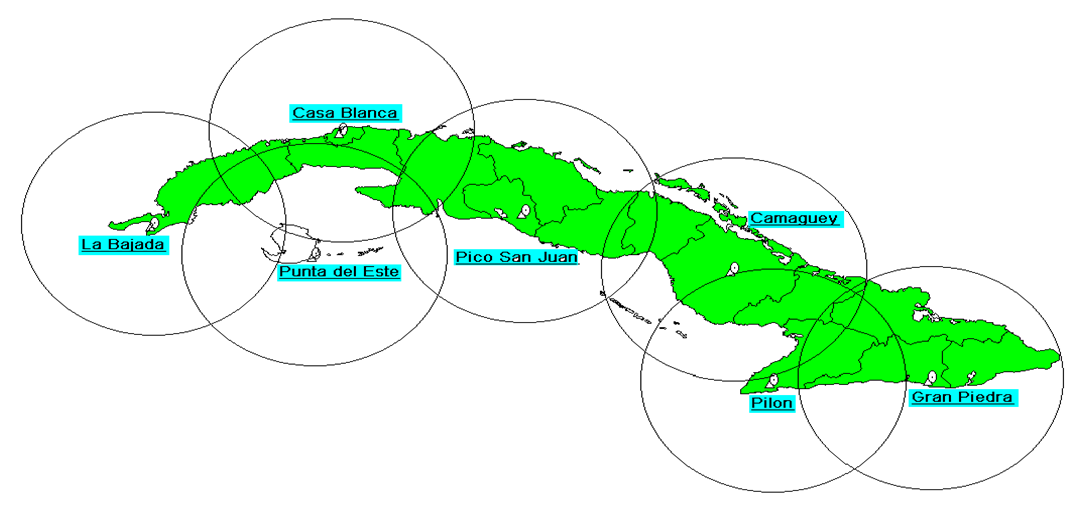Characterization of cells that generate Severe Local Storms in the Cuban archipelago through radar observations
Main Article Content
Abstract
The conditions for the formation and development of convective storms are very complex, and even more those producing severe events such as hail, downburst, tornadoes or waterspouts, making difficult to find common radar features that are usual on them. One of the best tools for this is meteorological radar, as it allows data to be provided within storms almost instantly. Based on this, this research is carried out, aiming to characterize the cells that generate Severe Local Storms in the Cuban archipelago through radar observations. Were analyzed 630 storms associated with severe events that occurred in Cuba between 2010 and 2021, through radar observations obtained from the Cuban network. The radar variables maximum reflectivity, maximum top of the convective cells, height of maximum reflectivity and the maximum height of reflectivity of 45 dBZ are analyzed. The results showed that 98.6% of the maximum reflectivity values in the storms exceeded 45 dBZ, and that 99.7% of the cases analyzed exceeded 8 km in height from their peaks, which demonstrates the intensity that characterizes Severe Local Storms in Cuba under a tropical and insular environment.
Downloads
Article Details

This work is licensed under a Creative Commons Attribution-NonCommercial 4.0 International License.
Those authors who have publications with this journal accept the following terms of the License Attribution-NonCommercial 4.0 International (CC BY-NC 4.0):
You are free to:
- Share — copy and redistribute the material in any medium or format
- Adapt — remix, transform, and build upon the material
The licensor cannot revoke these freedoms as long as you follow the license terms.
Under the following terms:
- Attribution — You must give appropriate credit, provide a link to the license, and indicate if changes were made. You may do so in any reasonable manner, but not in any way that suggests the licensor endorses you or your use.
- NonCommercial — You may not use the material for commercial purposes.
- No additional restrictions — You may not apply legal terms or technological measures that legally restrict others from doing anything the license permits.
The journal is not responsible for the opinions and concepts expressed in the works, they are the sole responsibility of the authors. The Editor, with the assistance of the Editorial Committee, reserves the right to suggest or request advisable or necessary modifications. They are accepted to publish original scientific papers, research results of interest that have not been published or sent to another journal for the same purpose.
The mention of trademarks of equipment, instruments or specific materials is for identification purposes, and there is no promotional commitment in relation to them, neither by the authors nor by the publisher.
References
Aguilar, G., Naranjo, L. & Carnesoltas, M. 2007. “Condiciones a escala sinóptica favorables para la aparición de Tormentas Locales severas en Cuba. Parte I: Período Poco Lluvioso”. Revista Cubana de Meteorología, vol.15, no.2 del 2009. INSMET.
Alfonso, A. P. & Córdoba, L. 1987: Los mesociclones del 16 de febrero en las provincias habaneras. Reporte de investigación. Insmet Cuba #16, 26 pp.
Alfonso, A. P. 1994. “Climatología de las tormentas locales severas de Cuba”. Cronología. La Habana, Cuba: Editorial Academia, 168 p., ISBN: 978-95-902-0060-1, [Consulted: 20 julio, 2023].
Briliov, G. B. & Gachina. S. B. 1984.” Diagnóstico del comportamiento vertical de las nubes en el fondo de una capa nubosa por parámetros de radiolocalización. Radiolocalización Meteorológica”. Leningrado 174 -177 pp (en Ruso)
Browning, K. A. 1965. “The evolution of tornadic storms”. J. Atmos. Sci., 22, 664–668.
Browning, K.A. 1977. “The Structure and Mechanisms of Hailstorms. In: Foote, G.B., Knight, C.A. (eds) Hail: A Review of Hail Science and Hail Suppression”. Meteorological Monographs, vol 16. American Meteorological Society, Boston, MA. https://doi.org/10.1007/978-1-935704-30-0_1
Byers, H. R. & Braham Jr., R. R. 1948. “Thunderstorm structure and circulation”, J. Meteorol., 5, 71–86.
Carnesoltas Calvo, M. 2002. “La circulación local de brisa de mar y tierra. Conceptos fundamentales”. Revista Cubana de Meteorología. Instituto de Meteorología. Ministerio de Ciencia, Tecnología y Medio Ambiente. Ciudad de La Habana. Cuba. Volumen 9. Número 1. 2002. 39-60 pp.
Córdoba, L. & Alfonso, A. P. 1992. “Sistemas frontales en el occidente de Cuba”. Revista Cubana de Meteorología 5 (1) 67 – 82 pp.
Donaldson, R. J. 1965. “Methods for identifying Severe Thunderstorm by radar: A Guide and bibliography”, Bull. Amer. Meteor. Soc, 46, 174 – 193 pp.
Fabry, F. 2015. "Meteorology and radar in Radar meteorology: principles and practice”. Cambridge Univ. Press, Cambridge, U.K. vol. ch. 1, pp. 10-25,.
Fraile R., Castro, A., Sánchez, J. L., Marcos, J. L. & López, L. 2001. “Noteworthy C-band radar parameters of storms on hail days in northwestern Spain”. Atmos. Res. 59-60, 41-61.
Gamboa, F., Vázquez, W., Rodríguez, O., Pérez, C. & Aroche, R. 1993. “Complejo Radárico Automático para la información de Lluvia Localizada (CRAILL)”. [Inédito] Informe Científico al INSMET.
Gamboa, F., 2004. “Selección de indicadores radáricos como productores de severidad”. Tesis en Opción al Título Académico de Máster en Ciencias Meteorológicas. Instituto Superior de Ciencias Aplicadas. Ministerio de Ciencia Tecnología y Medio Ambiente, 55 pp.
Hong, Y. & Gurley, J. 2014. “Radar Hydrology: Principles, Models, and Applications”. 1st edition. CRC Press Taylor & Francis Group. ISBN 9781466514614. DOI:10.1201/b17921
Houze, R. A. 1993. “Cloud Dynamics”. International geophysics series. 539 pp.
Varela, A. 2017. “Formación de tornados no asociados a superceldas en la región occidental de Cuba”. Tesis de Maestría en Ciencias Meteorológicas, La Habana, Cuba.
Watanabe, H., & Ogura, Y. 1987. “Effects of orographically forced upstream lifting on mesoscale heavy precipitation: A case study”. J. Atoms. Sci., 44, 661-675.
WMO Bulletin Vol. XV, No. 1 – January 1966 https://library.wmo.int/idurl/4/41586

